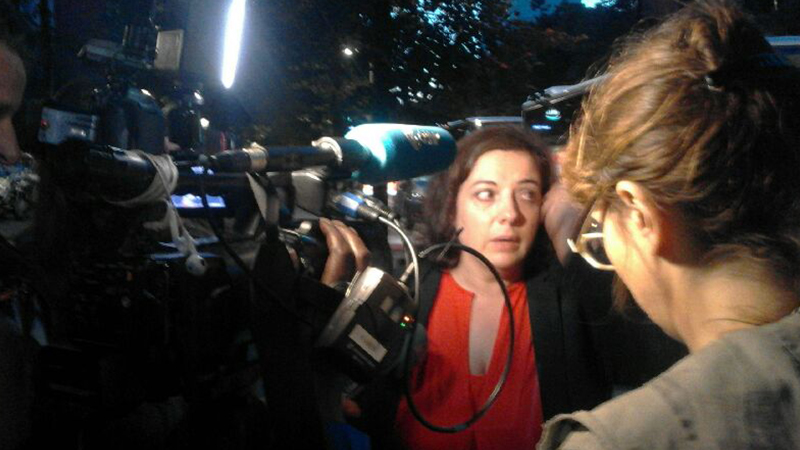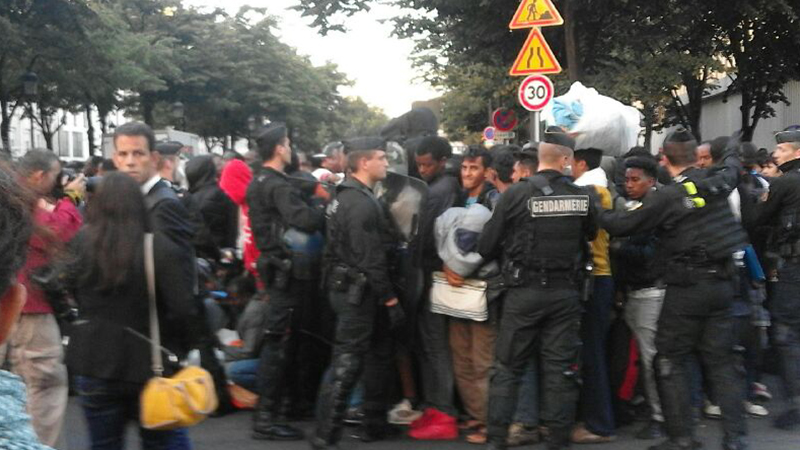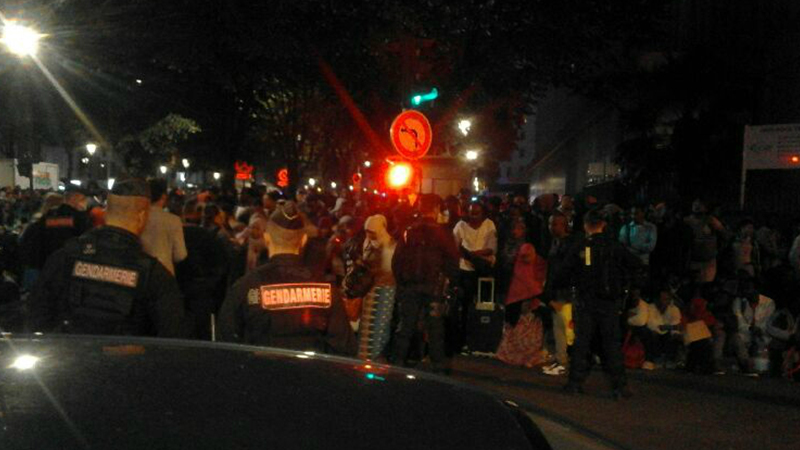Migrants wait during the evacuation of a camp near Stalingrad Metro on September 16, 2016 © Christophe Archambault / AFP
On September 16 at about 6am, between 1,000 and 2,000 migrants and asylum-seekers living on the streets in the north of Paris were rounded up by the police and bussed to housing centres at unknown locations elsewhere in France. It was the 28th evacuation of a Paris migrant camp since June 2015.
While media coverage of France’s homeless migrants has focused on the northern city of Calais, the streets of Paris have also been the sites of makeshift camps for thousands of refugees.
Municipal authorities say that the city has given temporary shelter to thousands of migrants living in the Paris region since June 2015. But city officials, NGOs and migrant activists agree that the system of forced evacuations and temporary housing isn’t working. After each evacuation the migrant camps re-form, turning areas near Stalingrad Metro, the Quai de Jemmapes and Avenue de Flandre at the junction of Paris’s 10th and 19th arrondissements (districts) into a bazaar of mattresses, tents and makeshift shelters. Eventually police dismantle the camps and the cycle repeats itself.
“We find ourselves in a vicious circle.”
- Ian Brossat, deputy mayor of Paris
In fact, the cycle has been repeated so many times that the city has no clear count of how many migrants are homeless in Paris, nor how many are currently staying in housing centres in the city. Paris Mayor Anne Hidalgo has said 17,000 migrants have been given shelter. But that number represents the number of times migrants have been placed in housing centres during all the evacuations, not the number of people in housing centres at any one time.
Meanwhile, the mayor’s office estimates that 60 to 70 new migrants arrive in Paris each day. Emmaüs Solidarité, an NGO that helps manage Paris’s migrant housing centres, said the number could be as high as 100 per day.
“We find ourselves in a vicious circle, going from camp to camp and from evacuation to evacuation,” Ian Brossat, deputy mayor of Paris in charge of housing, told FRANCE 24.
The city of Paris says it is working with the French government on initiatives that will not only get migrants off the street, but also find them long-term solutions. But can Paris really break the homeless migrant cycle?
Migrants wait during the Stalingrad evacuation, on September 16, 2016 © Christophe Archambault / AFP
According to activists who work with people in the migrant camps, the evacuations of Stalingrad follow a formula.
The police arrive around 5am or 6am, with no advance warning to the people in the camps.
Police place themselves in a cordon around the camp, then direct migrants onto buses. Activists say they are not told where they will be sent.
Migrants who happen to be outside the police cordon at the beginning of the evacuation – because they have gone to the toilet or are getting something to eat, for example – can be separated from family members and friends. They also risk losing their documents or possessions. A few hours after the operation of September 16, clean-up crews in facemasks and white jumpsuits could be seen putting mattresses and tents into dumpsters in the area of the Stalingrad Metro overpass.

Near Stalingrad Metro the morning after the evacuation of September 16, 2016 © Avi Davis, FRANCE 24
“You could have taken some pretty pictures this morning.” - Ludovic, resident of the Stalingrad neighbourhood
According to activists, migrants report that the evacuations can turn violent, with the police sometimes using tear gas on the crowds.
Houssam, an activist with the migrant-rights group Collectif la Chapelle Debout, said the dismantling of September 16 was also violent. Ludovic, a resident who said he lives across the street from the Stalingrad camp and saw the police move in, confirmed that there was violence on the part of the authorities.
“You could have taken some pretty pictures this morning,” he told FRANCE 24 wryly a few hours later.
But Nicolas Comte, a representative from France’s largest police union, Unité SGP Police-Force Ouvrière, told FRANCE 24 that he was not aware of any violence. He said that tear gas is occasionally used during evacuations, as one of the police’s “usual methods”. According to Comte, many migrants “leave on their own” without police coercion.
Activists and migrants say the police also use two other techniques to dismantle the migrant camps: expulsions and roundups. During expulsions, migrants are simply dispersed or forced out of the camp, without putting them on buses or directing them to alternative housing. During roundups, migrants are arrested and brought to the police station. Then they are released without charge.
“First of all we must have a place, then we can go ask for asylum.” - Muhammed, migrant from Afghanistan
Houssam said that the police use roundups as a tactic to “terrorise” homeless migrants. The Coordination Française pour le Droit d’Asile (CFDA), an association of migrant-rights groups that includes Amnesty International France as a member, condemned the police operations around Stalingrad Metro, saying they are designed “to dissuade people from requesting asylum”.
Despite the police operation, by 10am a few dozen migrants had returned to the area of the camps, once again setting up tents and mattresses.

Migrants return to a camp near Stalingrad Metro the morning after the evacuation of September 16, 2016 © Avi Davis, FRANCE 24
Wahidullah and Muhammed, both from Nangarhar province in Afghanistan, sat on a couch under the Stalingrad Metro bridge. They said they hadn’t been evacuated that morning because they were asleep in their tent. They both agreed that they want to stay in France.
“We want to be accepted here,” Wahidullah told FRANCE 24.
“First of all we must have a place, then we can go ask for asylum,” Muhammed said. “Just a room.”
The Lycée Jean-Quarré temporary housing centre in the 19th arrondissement of Paris, September 16, 2016 © Avi Davis
The Lycée Jean-Quarré in Paris’s 19th arrondissement is one of the temporary housing centres for migrants. It currently houses 145 migrants, mostly from Afghanistan.
The former vocational school was unoccupied when a group of homeless migrants began squatting there sometime in 2015. In October 2015, 1,300 of them were evacuated from the building. After €600,000 in investment from the city and the French state, Jean-Quarré was adapted into a housing centre that opened in February 2016.
Two to four people now sleep in each of the school’s former classrooms.
Bruno Morel, director general of Emmaüs Solidarité, which manages the centre in cooperation with the city, points out that Jean-Quarré is not simply a place to hold migrants.
”We are very proud of this centre because it had been a place of violence and a lack of rules; now it’s become a place where people are allowed to relax [and] think about what direction they will take in France,” Morel told FRANCE 24.

Two residents of the Lycée Jean-Quarré housing centre work on a computer with a staff member (centre), on September 16, 2016 © Avi Davis, FRANCE 24
Morel explains that the ground floor of Jean-Quarré houses a library and activity centre with computers the residents can use. French classes are taught here every afternoon.
Jean-Quarré is the model that the city of Paris would like to follow.
A team of 25 paid employees work at Jean-Quarré, including social workers, a cultural coordinator and a team to help the migrants integrate into daily life. Meals are provided three times per day by a neighbourhood organisation.
On the afternoon of the Stalingrad evacuation, two residents were working on the computer with the help of a French staff member. (None of the migrants in Jean-Quarré gave their names to FRANCE 24.) Others walked through a garden in front of the centre, planted with fruits and vegetables by migrants working with another neighbourhood group. In a basketball court next to the garden, two more residents of Jean-Quarré kicked a football back and forth.

The garden of the Lycée Jean-Quarré housing centre on September 16, 2016 © Avi Davis, FRANCE 24
But perhaps the most important feature of Jean-Quarré are the workers who assist migrants during the long process of applying for asylum in France.
Jean-Quarré is the model that the city of Paris would like to follow for other migrant housing centres. But activists say that, for the moment, few others are up to the same standards.
No place to cook
in Saint-Denis
Asif, from Afghanistan, and the housing centre in Saint-Denis, near Paris, where he currently lives. © Asif
Migrants who do not end up in Jean-Quarré are more likely to have an experience like that of Asif, an asylum-seeker who fled Afghanistan because the Islamic State group threatened his home district of Haska Mina.
Asif says some housing centres don’t even have showers.
Asif was given housing in a hotel with other migrants in the banlieue (suburb) of Saint-Denis north of Paris. He said there was no food served at the hotel and no place to cook. He and a group of other migrants have been receiving one meal per day from a neighbourhood restaurant in exchange for work.
Asif said some housing centres don’t even have showers, and that it’s conditions like these that send migrants back to the streets.
After applying for asylum in July, Asif was supposed receive €204 per month (€6.80 per day) to help with living expenses. He said he only received his first monthly stipend on September 17, which totalled only €88 euros.
Asif does not receive any state-sponsored counselling. Everything he knows about the complications of the asylum process in France he’s learned from first-hand experience, from other migrants or from activist groups like Collectif Parisien de Soutien aux Exilés (Parisian Collective for the Support of the Exiled, or CPSE) and Chapelle Debout, both of which are distrusted by the police. Unlike the residents of Jean-Quarré, no one is assigned to help him with his asylum application.
Migrants wait during the evacuation of a camp near Stalingrad Metro on September 16, 2016 © Christophe Archambault / AFP
What Asif has in common with the residents of Jean-Quarré is that their housing is temporary. How long they can stay is not clear: Deputy Mayor Brossat from the Paris mayor’s office said that migrants can stay in the temporary housing centres for “several months”. Jean-Quarré will no longer house migrants after mid-2017, by which time the city hopes to have converted it into a media centre.
A migrant is eligible for longer-term housing, at Welcome Centres for Asylum Seekers or CADAs, once they apply for asylum. But just getting to that point can be difficult. Asylum-seekers in Paris have to deal with four separate agencies: police headquarters, an NGO called France Terre d’Asile, and two government organisations called the Office for Immigration and Integration (OFII) and the Office for the Protection of Refugees and Stateless People (OFPRA).
Asif said he camped out in front of the France Terre d’Asile office in Paris for three weeks before he was able to get an appointment to request asylum.
“Maybe tomorrow there will be a problem and OFPRA will tell me, ‘Oh, you were lying.’” - Asif, asylum seeker
He said there were sometimes several hundred other migrants camping alongside him on the street. Activists who work with the migrants confirmed his story. Aubépine Dahan, a member of CPSE, said that the camps in the north of Paris were originally formed in part by migrants waiting to be admitted to the France Terre d’Asile office, which is located less than 1.5 kilometres from the Stalingrad Metro.
A representative confirmed that the Paris police prefecture only allows France Terre d’Asile to have 60 asylum appointments per day.
Difficulties can continue even after the asylum process has begun. Asylum-seekers give oral testimony as part of their application. The OFPRA website says that, “if necessary”, this testimony can be given with the help of an interpreter; 80 percent of applicants use a translator.
Asif, who does not speak French, said that no translator was made available so that he would be able to give testimony in his native Pashto. In the end he gave a written statement in English, which he does not speak fluently. Houssam of Chapelle Debout said that many migrants are denied access to an interpreter during their interviews.
Asif is worried that his English testimony might be perceived as inaccurate by the authorities.
“Maybe tomorrow there will be a problem and OFPRA will tell me, ‘Oh, you were lying,’” Asif said. “Because I just arrived from Afghanistan and there was no translator.”
Ian Brossat (L) with Anne Hidalgo during the Paris mayoral elections, March 2014 © Joel Saget / AFP
Despite stories like Asif’s, the man in charge of Paris’s housing initiatives remains optimistic about the city’s reception of migrants, saying the capital took the lead on welcoming migrants to France.
“I never saw a resident in my neighbourhood complain about the presence of a centre for refugees.” - Ian Brossat, deputy mayor of Paris for housing
“We’re a friendly city,” Brossat told FRANCE 24 three days before the evacuation. “I’m proud to live in a city whose first reaction was solidarity with the refugees.”
“I live 200 metres from one of the housing centres in the 18th arrondissement and I never saw a resident in my neighbourhood complain about the presence of a centre for refugees,” he added.
But Brossat agrees that the present situation needs fixing.
The city is working with the state to develop what he called an “initial welcome centre”, where single male migrants can receive immigration advice and shelter for one week immediately after arriving in Paris. It will open in mid-October near Porte de la Chapelle at the northern edge of the city. It will have the capacity to house 400 people when it opens and up to 600 by the end of the year.
A separate welcome centre for women is being established in Ivry-sur-Seine, a suburb southeast of Paris. It will open at the end of the year and will be able to host 350 women for up to three months each.
Left to right: French Housing Minister Emmanuelle Cosse at the September 16, 2016 evacuation; Police and migrants at the September 16, 2016 evacuation
Brossat explained, however, that the new welcome centres can only work if the state, which handles asylum cases, also makes more long-term housing available. If not, migrants leaving Paris’s initial welcome centres could find themselves back on the streets – a situation nobody wants.
“It’s negative for the migrants, who live in completely shameful conditions, and there are negative reactions from the residents” who live near the camps, Brossat says.
About 12 hours after the camp evacuation began on the morning of September 16, another police operation was launched near Stalingrad. This time, it was a roundup. Houssam of Chapelle Debout said that 60 migrants were taken into custody – but they were soon released, only to return to the streets.
















